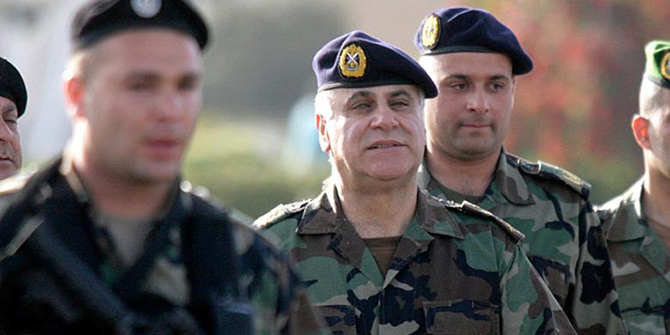by Robert Springborg, Sciences Po
This memo was prepared for ‘The Arab Thermidor: The Resurgence of the Security State’ workshop held at LSE on 10 October 2014 in collaboration with POMEPS.

If the subtitle of this workshop, “The Resurgence of the Mukhabarat State,” is meant to imply that resurgence of security and intelligence services is the key institutional feature of Arab “Thermidors,” it is misleading. It is the power of Arab militaries and militias, not mukhabarat, that has been dramatically enhanced in reaction to “Middle Eastern revolutions.” Egypt, now led by the former field marshal, President Abdel Fattah al-Sisi, is only the most obvious case in point of a region-wide trend that includes most other republics as well as monarchies. The Tunisian military, which served as the midwife of the “revolution,” enjoys much more status now than under either former presidents, Habib Bourguiba or Zine el-Abidine Ben Ali. Were the bumpy transition presently focused on end of year elections to derail yet again, the military might end up as at least the arbiter, if not the beneficiary of the ultimate allocation of political power. The struggle over command of the Lebanese military has been as intense, if rather less public, than the conflict over the presidential succession, suggesting the centrality of that institution to the country’s identity and politics.
In the other republics, whose states in general and militaries in particular have traditionally been less institutionalized than in those of Egypt and Tunisia, the resurgence of coercive power has been manifested in militaries and, to a greater extent, in militias. The Algerian military, the most robust of those in these other republics despite its internal divisions, has reasserted its centrality to le pouvoir at the expense of the Ministry of Interior’s Direction de la Surveillance du Territoire (DST), the presidency, and even its very own Department of Intelligence and Security (DRS), over which the decideurs generals have tightened their control. The fate of the shadowy forces allied to the military that formed shock troops against Islamist rebels during the civil war is unknown, but presumably they continue to exist and could be mobilized again if necessary. Remnants of the Libyan military, an institution subordinated by Moammar Gaddafi to the autonomous kataib (battalions) commanded either by his sons or tribal allies, then further marginalized by the victorious militias, are now trying to stage a comeback under General Khalifa Hifter or with his allied militias based in Zintan. This reconstituted military-militia, however, is facing stiff opposition from Ansar al-Sharia and other tribally and regionally based militias that have prospered in the vacuum of state authority, key of which are those centered in Misrata.
Militaries and militias in pre- and post-Arab Springs in Syria and Yemen are similar to those in Libya. In both countries the national military was cleaved into kataib commanded by presidential allies tied to him by blood, tribe, or sect. Civil war in Syria elevated the role of the kataib most closely connected to President Bashar al-Assad, while marginalizing the broader military whose role has been assumed by a newly created National Defense Force trained by Iran, Hezbollah fighters, and mercenaries. The Yemeni military, through which former President Ali Abdullah Saleh exercised his tribally based power, supplemented by tribal militias, appears to be the last remaining sovereign institution standing between continued territorial integrity and a failed state, as frantic U.S. efforts to shore it up attest. In reality, however, after the collapse of General Ali Mohsen’s forces in September, the only remaining hard core of that military is the division commanded by Saleh’s son Ahmad, as militias associated with the Islamist Islah movement are becoming the principal armed forces of northern Sunnis. The rising strength of militias connected to the Zaidi Houthis’ Ansar Allah movement in the North and Hirak secessionists in the South, to say nothing of various jihadi forces of which the strongest is al-Qaeda in the Arabian Peninsula, and of growing tactical alliances between these various challengers, suggest that like the Syrian military, the Yemeni one will be insufficiently institutionalized to survive post-Arab Spring challenges in a unified, coherent form.
>> read the full memo on the Pomeps Website
Other available memos in the series
‘The Authoritarian Impulse vs. the Democratic Imperative: Political Learning as a Precondition for Sustainable Development in the Maghreb’, John P. Entelis, Fordham University
‘Elite Fragmentation and Securitization in Bahrain’, by Toby Matthiesen, University of Cambridge
‘Militaries, Civilians and the Crisis of the Arab State’, by Yezid Sayigh, Carnegie Middle East Center
‘Arab Transitions and the Old Elite’, by Ellis Goldberg, University of Washington
‘Explaining Democratic Divergence: Why Tunisia has Succeeded and Egypt has Failed’, Eva Bellin, Brandeis University
‘Is Libya a Proxy War?’, Frederic Wehrey, Carnegie Endowment for International Peace
‘Fiscal Politics of Enduring Authoritarianism’, Pete W. Moore, Case Western Reserve University
‘Mass Politics and the Future of Authoritarian Governance in the Arab World’, Steven Heydemann, United States Institute of Peace
‘Security Dilemmas and the ‘Security State’ Question in Jordan’, Curtis R. Ryan, Appalachian State University
‘Authoritarian Populism and the Rise of the Security State in Iran’, Ali Ansari, University of St Andrews
‘A Historical Sociology Approach to Authoritarian Resilience in Post-Arab Uprising MENA’, Raymond Hinnebusch, University of St Andrews
‘The Arab Thermidor’, Marc Lynch, George Washington University



